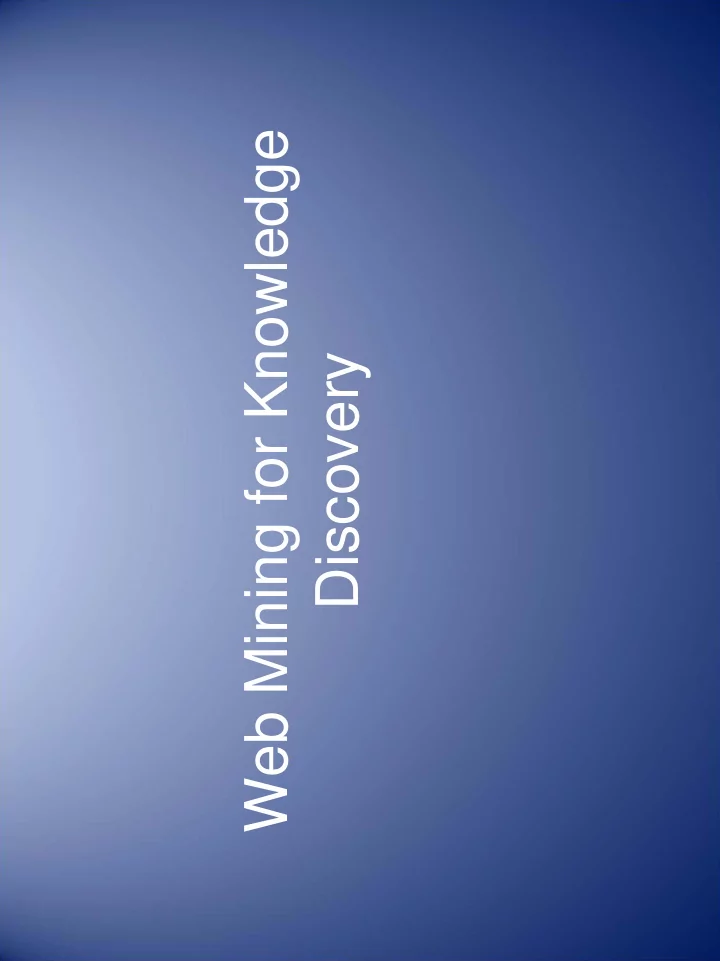

Web Mining for Knowledge Discovery
Current Search Engine • Search engines are doing good jobs so far • The idea is to use any of the popular search engine like Yahoo or Google • Building a web crawler that feeds on the results of the search engine
Scenario • Develop a way to collect the documents that match search criteria done by any of the popular search engine • A crawler will be built to feed on the links produced by the search results • Retrieve the documents • Extract words, do some processing, and Index • Categorize the document then Rank • Provide a simple search engine
Levels of Text Processing 1/6 • Word Level – Words Properties – Stop-Words – Stemming – Frequent N-Grams – Thesaurus (WordNet) • Sentence Level • Document Level • Document-Collection Level • Linked-Document-Collection Level • Application Level
Words Properties • Relations among word surface forms and their senses: – Homonomy : same form, but different meaning (e.g. bank: river bank, financial institution) – Polysemy : same form, related meaning (e.g. bank: blood bank, financial institution) – Synonymy : different form, same meaning (e.g. singer, vocalist) – Hyponymy : one word denotes a subclass of an another (e.g. breakfast, meal) • Word frequencies in texts have power distribution : – …small number of very frequent words – …big number of low frequency words
Processing: Stop-words • Stop-words are words that from non-linguistic view do not carry information – …they have mainly functional role – …usually we remove them to help the methods to perform better • Natural language dependent – examples: – English: A, ABOUT, ABOVE, ACROSS, AFTER, AGAIN, AGAINST, ALL, ALMOST, ALONE, ALONG, ALREADY, ALSO, ...
After the stop-words Original text removal Information Systems Asia Web - Information Systems Asia Web provides research, IS-related provides research IS-related commercial materials, commercial materials interaction, and even research interaction research sponsorship by interested sponsorship interested corporations with a focus on Asia corporations focus Asia Pacific Pacific region. region Survey of Information Retrieval - Survey Information Retrieval guide guide to IR, with an emphasis on IR emphasis web-based web-based projects. Includes a projects Includes glossary glossary, and pointers to pointers interesting papers interesting papers.
Processing: Stemming (I) • Different forms of the same word are usually problematic for text data analysis, because they have different spelling and similar meaning (e.g. learns, learned, learning,…) • Stemming is a process of transforming a word into its stem (normalized form)
Example cascade rules used in English Porter stemmer • ATIONAL -> ATE relational -> relate • TIONAL -> TION conditional -> condition • ENCI -> ENCE valenci -> valence • ANCI -> ANCE hesitanci -> hesitance • IZER -> IZE digitizer -> digitize • ABLI -> ABLE conformabli -> conformable • ALLI -> AL radicalli -> radical • ENTLI -> ENT differentli -> different • ELI -> E vileli - > vile • OUSLI -> OUS analogousli -> analogous
WordNet – a database of lexical relations • WordNet is the most well developed and widely used lexical database for English – …it consist from 4 databases (nouns, verbs, adjectives, and adverbs) • Each database consists from sense entries consisting from a set of synonyms, e.g.: – musician, instrumentalist, player – person, individual, someone – life form, organism, being
Categorizing • WordNet • Ontology progressivelly built and extracted • Keywords to build ontology • User help is required
Ranking • a neural network for ranking querie • The neural network will learn to associate searches with results based on what links people click on after they get a list of search results
Summarization • Task : the task is to produce shorter, summary version of an original document. • Two main approaches to the problem: – Knowledge rich – performing semantic analysis, representing the meaning and generating the text satisfying length restriction – Selection based
Selection based summarization • Three main phases: – Analyzing the source text – Determining its important points – Synthesizing an appropriate output • Most methods adopt linear weighting model – each text unit (sentence) is assessed by: – Weight(U)=LocationInText(U)+CuePhrase(U)+Statisti cs(U)+AdditionalPresence(U) – …a lot of heuristics and tuning of parameters (also with ML) • …output consists from topmost text units (sentences)
Visualization 1. The text is split into the sentences. 2. Each sentence is deep-parsed into its logical form � we are using Microsoft’s NLPWin parser 3. Anaphora resolution is performed on all sentences � ...all ‘he’, ‘she’, ‘they’, ‘him’, ‘his’, ‘her’, etc. references to the objects are replaced by its proper name 4. From all the sentences we extract [Subject-Predicate- Object triples] (SPO) 5. SPOs form links in the graph 6. ...finally, we draw a graph
Recommend
More recommend